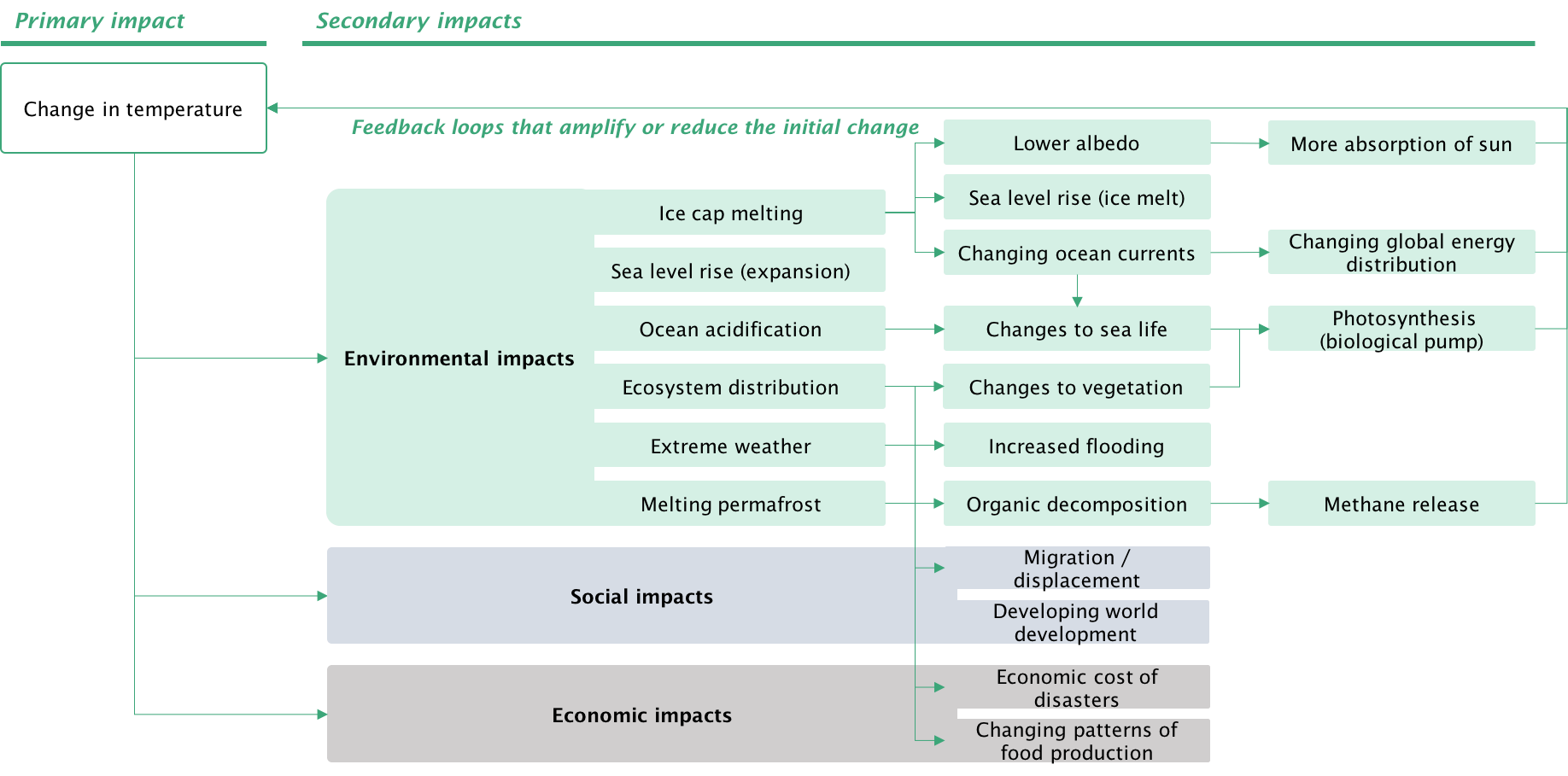The primary impact of human induced climate change is an increase in atmospheric temperature as a result of the enhanced greenhouse effect. However, because of the linkages between the atmosphere, land and oceans, this increase in temperature has many other significant environmental, social and economic impacts. These include rising sea levels resulting from melting ice caps and expansion of water at higher temperatures, increased frequency of extreme weather events and changes to ocean circulation patterns. Climate change is therefore likely to result in a very different world to that we know today.

The natural environment is a central building block for economies and societies. Any changes to the environment will influence the way in which humans can interact with their environment, altering these building blocks. Climate, being a key component of the environment, is a driver of environmental change and the consequential changes to economies, societies and cultures. This section explores the link between the climate and the natural and man-made environments in which we live.
Changes to the earth's temperature is a primary effect of climate change. Due to the linkages between the earth's systems, this change in temperature has multiple secondary effects. Examples of these secondary effects are provided in the diagram below:

The climate is a fundamental component of the wider natural environment. At the broadest level, climate determines whether land is rainforest, desert, ice covered or temperate. As discussed elsewhere on this website, climate results from the long-term patterns of transfers of energy around the globe. This involves multiple complex interactions between the earth systems (the land, oceans and atmosphere) that are difficult to model and forecast. Any changes to one of these elements risks creating knock-on impacts elsewhere, which may serve to re-inforce or reduce the initial change as part of complex feedback loops. There has been significant research focused on understanding how the different earth systems interact, and how a change to climate (an increase in temperature brought about by increased greenhouse gas concentrations) impacts on the long-term ocean and land environments. Potential impacts include melting ice caps, changes to ocean circulation patterns, flooding in low-lying coastal areas, a higher frequency of extreme natural hazards, the acidification of the oceans, shifting vegetation patterns and the migration of species. Some locations are more sensitive to these changes, such as coastal areas or regions relying on particular ocean currents. The environmental impacts of climate change are explored more in this section.
Societies rely on their environments to provide food, places to live, work, recreation and to provide other resources for building, energy production, natural resources and water and as a sink for wastes. Changes to the environment risk reducing the ability of the environment to serve societies in an optimal way, forcing changes in such societies. For example, changing vegetation patterns impact the ability to grow certain crops, impacting the population that can be supported and resulting in changing diets, migration or the population falling. Increased flooding in coastal areas is likely to force the migration of population away from those locations. Certain parts of society are likely to be better able to adapt to the effects of climate change than others. Developing countries located in areas that are particularly sensitive to the environmental impacts of climate change are likely to be most effected. A lack of access to technology, resources and capital required to successfully adapt to significant changes in the environment further means the societies that inhabit such locations are particularly exposed to the impacts of climate change. Further, climate change creates a number of fundamental questions about the ways in which society acts between generations (the impacts of climate change are likely to be suffered by different generations to those that contributed to it) and the developed and developing world. This is explored more in this section.
Natural resources are a key input into the economy. Applying human resource and capital to natural resources produces goods of value that can be traded, creating economic growth. The more natural resource that is converted to higher value goods through these applications, the more wealth and development is created as a result. Whilst the costs of labour and raw materials are included, the costs of releasing greenhouse gases, and the associated impacts on the environment and societies, are not factored into this economic process (such costs are therefore referred to as an 'externality'). Economic decision making does not therefore correctly 'price' the long-term impacts of economic growth on the environment. Economic growth and greenhouse gas emissions have historically been inherently linked, starting with the significant release of greenhouse gases that occurred during the industrial revolution as coal and the internal combustion engine drove a rapidly growing economy. Decoupling rising emissions and growth is a key objective of climate change mitigation (see this section). However, in time, the impacts of climate change are likely to include economic consequences, as a result of the increased costs of adapting to different environments and/or replicating services the natural environment can no longer offer. This is explored more in this section.